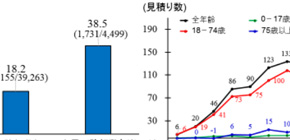
Public-access defibrillation increases the survival in patients with cardiac arrest in Japan
Early defibrillation by AED is crucial for saving lives of patients with out-of-hospital cardiac arrests. The use of publicly accessible automated external defibrillators (AEDs) can reduce the time from cardiac arrest to defibrillation for such patients. In Japan, the use of AEDs by the general public was legally permitted in July 2004. In 2013, more than 420,000 AEDs are placed in public places. As the installation of AEDs in public places increases in Japan, the use of AEDs by the general public is also on the rise. However, nationwide evaluation of the effect of dissemination of public-access AEDs for patients with out-of-hospital cardiac arrest has not been performed.
A group of researchers led by Professor IWAMI Taku at Kyoto University and Assistant Professor KITAMURA Tetsuhisa at Osaka University verified that the number of cardiac arrest survivors by the use of AED by bystanders has increased.
This group identified out-of-hospital cardiac arrest patients from 2005 to 2013 whose ventricular-fibrillation arrests were witnessed by bystanders and to whom resuscitation was attempted from the Fire and Disaster Management Agency’s survey on emergency patients in cardiac arrest who were transferred to a hospital. Using survival at 1 month with a favorable neurologic outcome as a primary endpoint, this group examined the number of survivors who were treated with AED by bystanders and recovered well. According to the data, of 43,762 patients with out-of-hospital cardiac arrest witnessed by bystanders during the survey period, 4,499 (10.3%) received public-access defibrillation.
The individuals who received public-access defibrillation increased from 1.1% in 2005 to 16.5 % in 2013. The percentage of patients who were alive at 1 month with a favorable neurologic outcome was significantly higher with public-access defibrillation than without public-access defibrillation (38.5% vs.18.2%.) The estimated number of patients who were alive at 1 month with a favorable neurologic outcome due to public-access defibrillation increased from 6 in 2005 to 201 in 2013.
This study verified that the dissemination of public-access AED increased public-access defibrillation and contributed to the increase in the survival of cardiac arrest patients. This will promote further dissemination of AEDs around the world. However, we can say that the number of survivors is not high in proportion to the dissemination of public-access AEDs. So, we will strive to promote education and social movement in order to increase the use of AEDs.
Although the effectiveness of the dissemination of AEDs was verified, cost-effectiveness should be discussed for further dissemination. Through the use of social networking applications on smartphones, we will also make efforts to build systems for increasing the use of AEDs and implement their evaluation, including dispatch of AEDs and life savers to patients in cardiac arrest.
Background
Early defibrillation plays a key role in improving survival in patients with out-of-hospital cardiac arrests due to ventricular fibrillation (ventricular-fibrillation cardiac arrests), and the use of publicly accessible automated external defibrillators (AEDs) can help to reduce the time to defibrillation for such patients. However, the effect of dissemination of public-access AEDs for ventricular-fibrillation cardiac arrest at the population level has not been extensively investigated.
Methods
From a nationwide, prospective, population-based registry of patients with out-of-hospital cardiac arrest in Japan, we identified patients from 2005 through 2013 with bystander-witnessed ventricular-fibrillation arrests of presumed cardiac origin in whom resuscitation was attempted. The primary outcome measure was survival at 1 month with a favorable neurologic outcome (Cerebral Performance Category of 1 or 2, on a scale from 1 [good cerebral performance] to 5 [death or brain death]). The number of patients in whom survival with a favorable neurologic outcome was attributable to public-access defibrillation was estimated.
Results
Of 43,762 patients with bystander-witnessed ventricular-fibrillation arrests of cardiac origin, 4499 (10.3%) received public-access defibrillation. The percentage of patients receiving public-access defibrillation increased from 1.1% in 2005 to 16.5% in 2013 (P<0.001 for trend). The percentage of patients who were alive at 1 month with a favorable neurologic outcome was significantly higher with public-access defibrillation than without public-access defibrillation (38.5% vs. 18.2%; adjusted odds ratio after propensity-score matching, 1.99; 95% confidence interval, 1.80 to 2.19). The estimated number of survivors in whom survival with a favorable neurologic outcome was attributed to public-access defibrillation increased from 6 in 2005 to 201 in 2013 (P<0.001 for trend).
Conclusions
In Japan, increased use of public-access defibrillation by bystanders was associated with an increase in the number of survivors with a favorable neurologic outcome after out-of-hospital ventricular-fibrillation cardiac arrest.

To learn more about this research, please view the full research report entitled “ Public-Access Defibrillation and Out-of-Hospital Cardiac Arrest in Japan ” at this page of the New England Journal of Medicine website.
Related link
